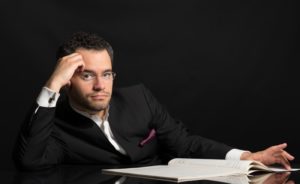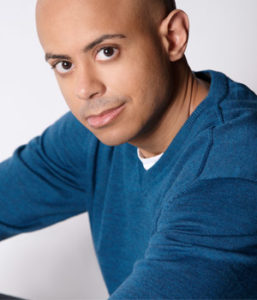Choices, choices: a job interview in the North Bay
The Santa Rosa Symphony is in the middle of an exciting journey as they change artistic directors. Bruno Ferrandis, their beloved conductor, is stepping down and returning to France after eleven years at the helm. He balanced an electric tautness with depth of feeling, and the orchestra will surely miss him. But this year Sonoma audiences get to hear five different conductors strut their stuff, and they are even encouraged to offer their comments to the hiring committee.
On Monday, Dec. 4, I heard the third of the five candidates, Andrew Grams, in a program titled “A Luscious Euro Sound.” Built around Ravel’s playful Piano Concerto in G Major, this was a program of contrasts.

Grams was interviewed beforehand by music historian Kayleen Asbo, and she asked him several tough questions.
KA: Can you talk about your journey here?
AG: I was very privileged to grow up when and where I did. One of the fun things about growing up outside of Baltimore back then is that we had THREE classical music stations on the radio. Classical music was always in the house (and we called it “serious music” because classical is a misnomer). When I was in the third grade my mother signed me up for string instruction, and I wanted that so I could get out of math class. I studied violin… and that began my journey all the way to Juilliard and later into conducting. My mother was very supportive, and I cannot overstate the luck and the willingness of a lot of people to shepherd me through this. How we get to where we get is how we get to where we get!
KA: But why music?
AG: Because it’s the best stuff! We cannot always articulate what it is about music… It’s just the best stuff!
KA: I believe that the Santa Rosa Symphony is the heart and soul of this community. What can you say about this?
AG: Music is the medium by which we come together. It is the opposite of race and religion. It is a force for bringing people together into meaningful dialogue.
KA: You travel a lot. Moving to Sonoma County is not in your plans, right?
AG: I have a “residence” outside of Cleveland, where I live about two months a year with my love, who plays with the Cleveland Orchestra. And then I guest conduct a lot. If I get this job I will cut down a lot on my guest conducting. Think of it like dating: you go out a couple of times and then you think, It’s fun. But do I need it? So I’ll cut down on some of that…And this conductor search is like speed dating.
KA: [laughs] Yes, it is like speed dating. But we’re not looking for one night stands!
Grams answered smoothly, talking about sharing what he loved with the musicians and community. But I don’t think he was expecting that sweetly smiling musicologist to have such a wicked thrust.
And then on to the tryout! They opened with Hector Berlioz’ King Lear Overture. This was not the mature Berlioz that we know from Symphonie Fantastique, with his command of orchestration and color and smooth transitions. This was the young Berlioz, rough and rocky and fresh from being jilted by the woman he hoped to wed. It may not have been smooth, but in this homage to Shakespeare’s Lear we could hear a King’s madness echoed by a young man’s descent into insane passions.
Grams spoke about the work first, telling us that Berlioz had actually planned to dress as a chambermaid and poison his intended and her mother (who had halted the engagement) and himself, and was traveling from Rome when he stopped in Nice and encountered the Shakespeare play. He managed to regain enough sanity to write this concerto.

Despite the fascinating back story, this was not as successful as it could have been. Perhaps Grams was trying too hard, varying the tempo too often and stopping for long moments before springing back into action. The strings were right with him on those pauses, and started up instantly together. But the horns were ragged, since he didn’t know to telegraph his down beat for them. You just can’t do that to a horn player! They need to know where the beat is going to be, so they can get their mouths puckered down and begin compressing a column of air.
In that moment I knew his violin training was actually interfering with his rapport with the brass.
But then they came powerfully together in Maurice Ravel’s Concerto in G major for Piano and Orchestra, with a dynamic performance by young piano sensation Stewart Goodyear.
This was all that the audience could have wished for, with sparkling runs and deep melancholy and lots and lots of Euro-jazz! But here Grams’ job was more direct: he had to follow the soloist faithfully or court instant disaster. No sweeping gestures, no grand pauses. This was that supreme tightrope act that conductors have to do, supporting the soloist’s interpretation of the composer and his rapport with the orchestra.
And the older Ravel was a force of nature, with whole tones mixing it up with blue notes and explosive runs turning to reveries. Goodyear was slow and tragic in the middle movement, and the excellent program notes by Steven Ledbetter described how Ravel “found it necessary to write the Adagio assai one or two measures at a time.”
Along with the full-court piano runs, the orchestra was at the top of its form. The brass were magically tight, the flutes glittered like precious stones, and the harp mirrored piano to create a sense of unearthly distance.
After intermission, the orchestra tried to show its mettle in Rachmaninoff’s Symphonic Dances, and it was clear that these musicians were solid. But again there were problems getting the work to gel into clarity. The patron seated next to me leaned over and whispered, “Grams looks like he’s dancing.” She didn’t seem to approve of his sways and round gestures, and I think the brass were having trouble finding the center of his beat.
I tried to think how Rachmaninoff would have conducted his own work of lush chords and bright edges. Stravinsky called him “a six-foot-six-inch scowl.” He would have stood ramrod straight and conducted incisively, and the musicians would have sounded sublime.
Last month Mei-Ann Chen had her tryout, and I read that both audience and musicians connected strongly to her. That program included a brilliant work by contemporary American composer Jennifer Higdon, and I’m sorry that I missed it. But we still have two more excellent candidates, and I’m all ready for “speed dating.”
For complete information on these concerts and on this exciting search for a conductor see srsymphony.org.
—Adam Broner
Photo top of Andrew Grams, courtesy of the SR Symphony; below of Stewart Goodyear, photo by Anita Zvonar.
